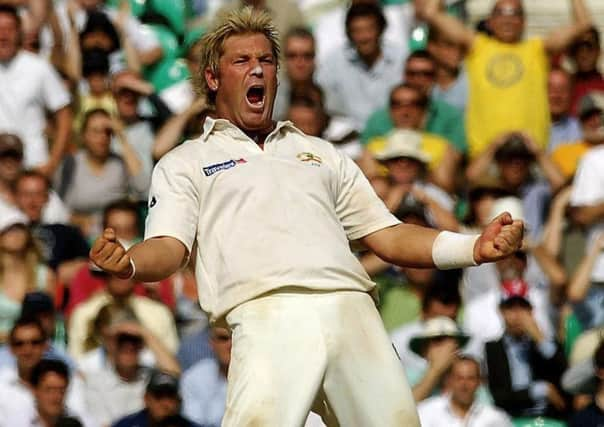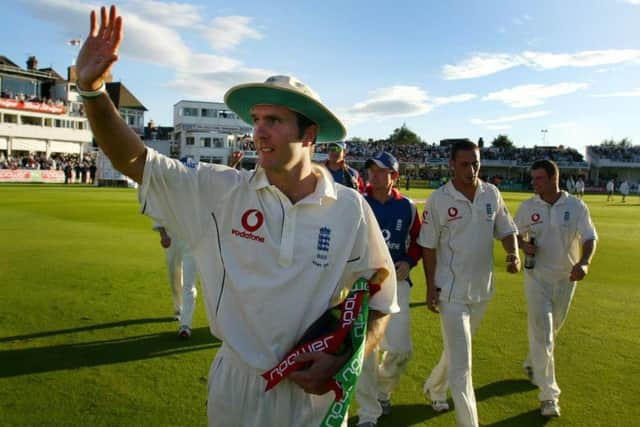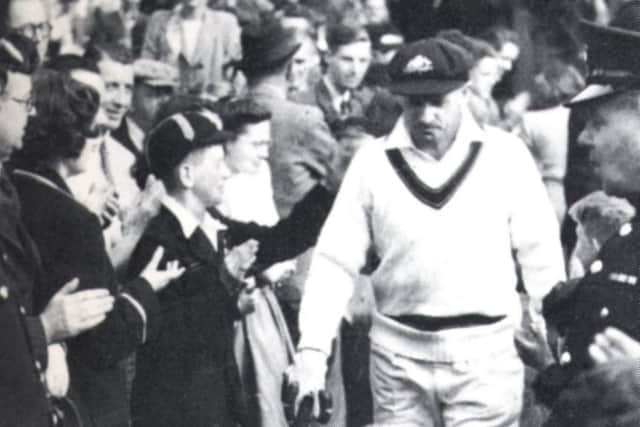Sports books - Cricket: Victory by Vaughan's upstarts lives long in memory


“Look up and down the Australian team that Ricky Ponting led,” adds Haigh, “and it is hard to spot a weakness: Matthew Hayden and Justin Langer; Damien Martyn and Michael Clarke; Adam Gilchrist, for heaven’s sake. That’s before you’re even at perhaps history’s greatest bowling combination, Shane Warne and Glenn McGrath. The cricketers of the next rank slot there only by comparison, from Jason Gillespie and Brett Lee to Michael Kasprowicz and Shaun Tait.
“England? Michael Vaughan was guarded by two solid openers, Marcus Trescothick and Andrew Strauss, and could place his own new ball with an honest toiler in Matthew Hoggard and a professional enigma in Steve Harmison. Then, well: Ashley Giles? Geraint Jones? Ian Bell in his first series and Simon Jones in his last? And a year out, what could have been said of Andrew Flintoff, who at the time averaged 25 with the bat and 40 with the ball, and Kevin Pietersen, who had played three county seasons as a batsman after arriving from South Africa as an off-spinner?
Advertisement
Hide AdAdvertisement
Hide Ad“Perhaps Mystic Meg saw it coming; cricket’s cognoscenti saw little reason to imagine other than a continuation of a decade of Australian cricket hegemony.”


Unsurprisingly, Haigh, the Australian writer, names that 2005 series which England won 2-1 as one of the five greatest in Ashes history.
His other choices are the Bodyline series of 1932-33, the Len Hutton-led trip Down Under in 1954-55, the drawn series in England in 1972, and the Ian Botham-inspired summer of 1981, one capped by England’s back-from-the-dead victory at Headingley.
Having had the good fortune to cover the 2005 series for The Yorkshire Post, I can well relate to Haigh’s view that it is difficult to believe that the events of that summer actually took place.
Advertisement
Hide AdAdvertisement
Hide AdIndeed, it is almost as if we half-imagined them, as though they came from the pages of a Hans Christian Andersen fairytale.


Australia, the kings of world cricket and holders of the Ashes for 16 years, were toppled in a series burned deep into the memories of all who saw it, whether live at the grounds or on free-to-air television. Indeed, when the tortuous, nerve-jangling drama was done, I knew immediately that I would never cover a sporting event like it again.
All the memories of 2005 come flooding back in Anthology of the Ashes, the perfect companion to the latest instalment of cricket’s oldest rivalry that is currently unfolding Down Under.
From Australia’s 239-run win in the first Test of 2005 at Lord’s, followed by the drama of England’s narrow victories at Edgbaston and Trent Bridge which flanked a thrilling draw at Old Trafford, to Kevin Pietersen’s series-clinching hundred in the last Test at the Oval, this splendid book relives the jaw-dropping action.
Advertisement
Hide AdAdvertisement
Hide Ad“Simply the tensest, most exciting Test series ever,” asserts the anthology.


It is not a conclusion that will brook much argument.
Of course, there is much more to the history of the Ashes than 2005, or even the Bodyline campaign of 1932-33, when Harold Larwood and Douglas Jardine downed Don Bradman and co.
From the birth of the rivalry in the 1880s, after Australia achieved a shock win at the Oval, it has been notable not only for its headline series, but also for the breadth of great players to have graced its annals.
Simon Hughes, the former Middlesex pace bowler and editor of The Cricketer, starts the anthology by picking his greatest Ashes XI, with essays on each.


Advertisement
Hide AdAdvertisement
Hide AdHis composite selections are: Jack Hobbs, Len Hutton, Don Bradman, Wally Hammond, Allan Border, Ian Botham, Adam Gilchrist, Shane Warne, Jim Laker, Dennis Lillee and Glenn McGrath.
Inevitably, there are a few notable omissions, including the former Yorkshire opening batsman Herbert Sutcliffe – “the only Englishman to have a Test average of more than 60” – and former Yorkshire pace bowler Fred Trueman, “first man to 300 Test wickets”.
Indeed, you can almost hear Trueman protesting from the Elysian Fields: “Er, hang on a minute, Yosser, lad.
“I was t’finest bloody fast bowler that ever drew breath, tha knows.” Although off-spinner Laker was born in Bradford, the only man to have played for Yorkshire in Hughes’s list is batsman Hutton.
Advertisement
Hide AdAdvertisement
Hide AdHughes relates a “terrible old joke” that puts Hutton’s fame into perspective.
“Two Yorkshire neighbours arrive at the Headingley Test but realise they have forgotten their sandwiches,” he writes. “Being a Yorkshireman, one goes back home to get them. When he returns he has a grave look on his face. ‘I’ve got bad news,’ he says. ‘’Ouse has burnt down, wife’s run off and kids are in’t street in tears.’ ‘And I’ve got bad news for thee too,’ says his mate. ‘’Utton’s out!’”
The Cricketer’s James Coyne chooses his five Ashes flashpoints, starting with Bodyline, while colleague Jamie Crawley delves through the magazine’s archive to find the boldest, pithiest and most emotive Ashes-inspired writing.
This even extends to readers’ letters, with this, after England won Down Under in 2010-11, a personal favourite:
Advertisement
Hide AdAdvertisement
Hide Ad“Ian Chappell, Jason Donovan, Kylie Minogue, Evonne Goolagong, Germaine Greer, Paul Hogan, Barry Humphries, Ned Kelly, Rod Laver, Madge Bishop, Rolf Harris – can you hear me? Rolf Harris? Your boys took one hell of a beating!” – Austin Baird, Cramlington, Northumberland.
Four years later, after England reverted to type and lost 5-0, Baird put pen to paper once again:
“Ah lads. You’re back. I’ve been worried. After following you for 40 years with debacle following debacle, I was starting to think that alien doppelgangers were making a concerted effort at world domination.
“But no. Thankfully the England we all know and love has returned.
Advertisement
Hide AdAdvertisement
Hide Ad“Good old England. I can handle failure. It’s the hope I can’t stand.”
Along with a comprehensive statistics section, which reveals that there had been 533 hundreds and 533 five-fors heading into the present series, amid other curiosities, The Cricketer’s Huw Turbervill, sheds light on some of the less-heralded players who have graced the Ashes in a section entitled “15 Minutes of Fame”.
He pays tribute to the likes of former England bowler Richard Ellison, “who provided me with a particularly vivid memory of my teenage years, when he sliced through the Australians at Edgbaston in 1985”.
Turbervill goes on: “BBC1 had switched to the six o’clock news so I had to listen in on a radio at my grandmother’s house in Wales.
Advertisement
Hide AdAdvertisement
Hide Ad“Up and down the stairs I ran to delightedly report the fall of another wicket.”
There is some great writing here, some great nostalgia, and plenty to keep you entertained on a cold winter’s night.
Above all, it is a timely reminder of the history and heritage of cricket’s greatest rivalry.
The Cricketer Anthology of the Ashes is published by Allen & Unwin, priced £20.
Digging deep into county’s cricket lore
Advertisement
Hide AdAdvertisement
Hide AdEVER wondered how Yorkshire cricket developed in the 19th century, how it came to be a game that meant so much to so many, and how its local clubs were organised and financed?
These are among the issues covered expertly in A Game Taken Seriously: The Foundations of Yorkshire’s Cricketing Power by Jeremy Lonsdale.
It is as well that cricket throws up men like Lonsdale, who appear to consider it a duty to shed light on areas demanding prodigious research.
This is the archetypal labour of love, describing how people all over Yorkshire came to embrace the sport and influence its growth.
Advertisement
Hide AdAdvertisement
Hide Ad“A look at the record books will confirm that Yorkshire County Cricket Club is the most successful club in English cricket, and this book examines the foundations of that success back when it started in the 19th century,” writes Lonsdale.
It is a tour de force of research and endeavour.
A Game Taken Seriously: The Foundations of Yorkshire’s Cricketing Power by Jeremy Lonsdale is published by the Association of Cricket Statisticians and Historians, priced £20.